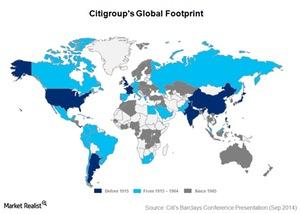Citigroup globally established in emerging markets
Citigroup’s exposure in emerging markets is mainly to investment-grade global multinationals through its institutional businesses.
Nov. 27 2019, Updated 7:18 p.m. ET

Significant global operations
Unlike its peers, Citigroup (C) has truly global operations. It has operations in more than 160 countries. Over 55% of Citigroup’s revenues come from outside the US. In comparison, only 14% of Bank of America’s (BAC) and 25% of JP Morgan’s (JPM) revenues are non-US. Wells Fargo (WFC) and other smaller banks held by the Financial Select Sector SPDR ETF (XLF) have much smaller international operations. So, Citigroup is ahead of its competitors when it comes to global presence.
Citigroup is well established in most of the countries where it operates, as you can see in the map above. This gives the bank a unique early-mover advantage. It has the potential to expand operations in one or more of the markets in which it’s present. Global presence gives Citigroup the ability to support clients as they grow and transact across countries. It can leverage its resources by strategically allocating them across markets.
Focus on emerging markets
As shown in the graph above, around 43% of the bank’s revenues come from emerging markets, and 12% come from the UK and other developed markets. A higher exposure to faster-growing emerging markets offers the bank immense growth potential. As well, the bank’s exposure to emerging markets is diversified. Diversified operations make its results less dependent on the performance of a single economy.
To mitigate the risks associated with emerging markets, the bank actively manages its activities and exposures. The bank’s exposure in emerging markets is mainly to investment-grade global multinationals through its institutional businesses. Its consumer banking operations primarily target high-credit quality, emerging affluent, and effluent consumers in the world’s top cities.
Next, we’ll take a closer look at Citigroup’s cards business.
